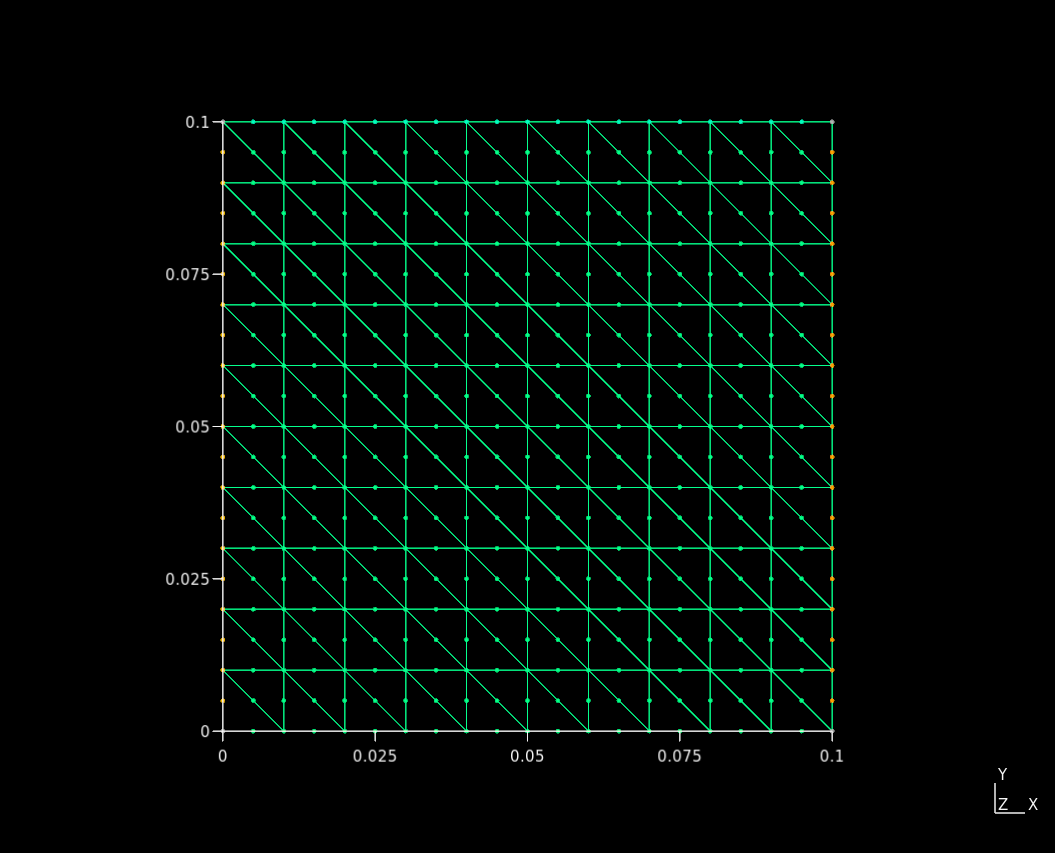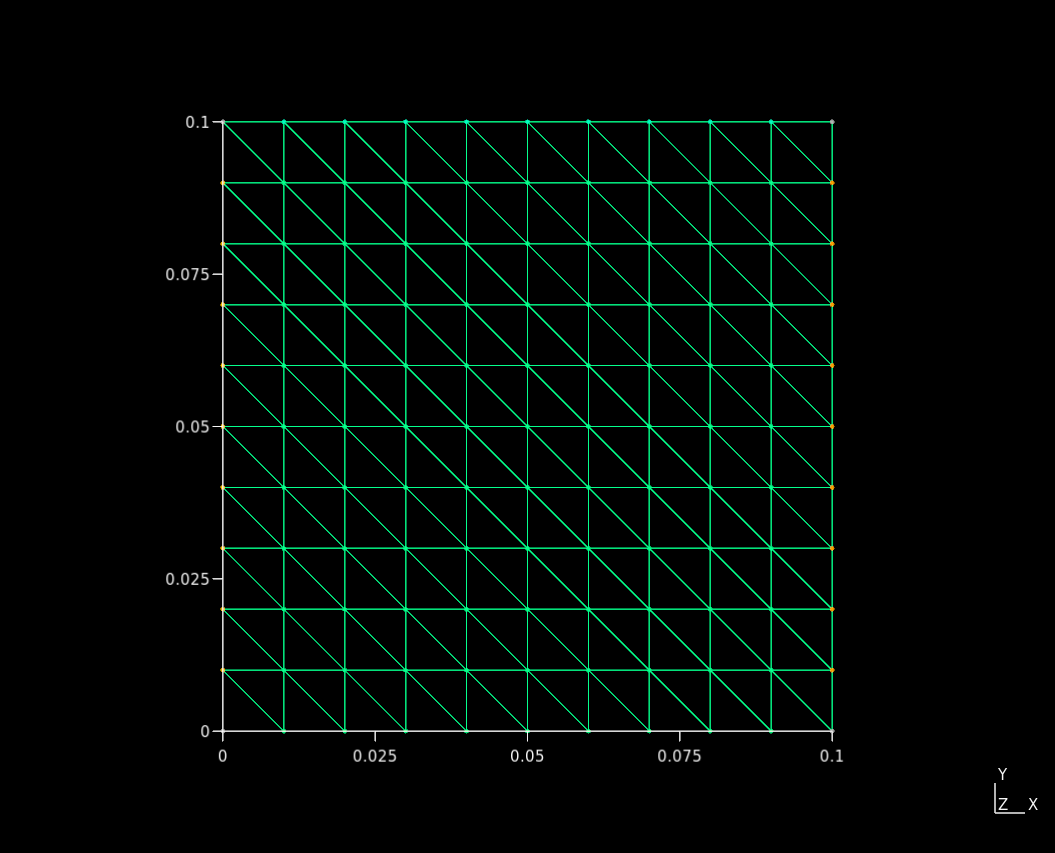AddFluidMaterial
This routine adds Fluid material to the AbstractSteadyStokes.
- It also prepares
obj%FluidMaterialToMesh(materialNo)andobj%fluidMaterial(materialNo). paramcontains the parameters for constructing a FluidMaterial.materialNameis the name of material, it should befluidMaterial.regionis an instance of MeshSelection_.
caution
materialNo should be lesser than or equal to the total
number of Fluid materials.
Interface
- ܀ Interface
- ️܀ See example
- ↢
INTERFACE
MODULE SUBROUTINE addFluidMaterial(obj, materialNo, materialName, &
& param, region)
CLASS(AbstractSteadyStokes_), INTENT(INOUT) :: obj
INTEGER(I4B), INTENT(IN) :: materialNo
CHARACTER(LEN=*), OPTIONAL, INTENT(IN) :: materialName
TYPE(ParameterList_), OPTIONAL, INTENT(IN) :: param
TYPE(MeshSelection_), OPTIONAL, INTENT(IN) :: region
END SUBROUTINE addFluidMaterial
END INTERFACE
In this example we will learn how to add a fluid material in the kernel.
- ܀ Mesh for velocity
- ܀ Mesh for pressure
- ↢


Use modules
PROGRAM main
USE easifemBase
USE easifemClasses
USE easifemMaterials
USE easifemKernels
USE SteadyStokes221_Class
IMPLICIT NONE
Declare variables
TYPE( SteadyStokes221_ ) :: obj
TYPE( ParameterList_ ) :: param
TYPE( DomainPointer_ ) :: domains(2)
CLASS( Domain_ ), POINTER :: dom => NULL()
CHARACTER( LEN = * ), PARAMETER :: domainFileNamePressure="./mesh_tri3.h5"
CHARACTER( LEN = * ), PARAMETER :: domainFileNameVelocity="./mesh_tri6.h5"
TYPE(String) :: filename(2)
New variables in this example:
TYPE( MeshSelection_ ) :: region
Set parameters
Set parameters for kernel.
CALL FPL_INIT(); CALL param%Initiate()
CALL SetSteadyStokes221Param( &
& param=param, &
& isConservativeForm=.TRUE., &
& gravity = [0.0_DFP, -9.8_DFP, 0.0_DFP], &
& domainFileForPressure = domainFileNamePressure, &
& domainFileForVelocity = domainFileNameVelocity, &
& engine="NATIVE_SERIAL", &
& CoordinateSystem=KERNEL_CARTESIAN, &
& maxIter = 100, &
& rtoleranceForPressure = REAL( 1.0E-6, DFP ), &
& rtoleranceForVelocity = REAL( 1.0E-6, DFP ), &
& atoleranceForPressure = REAL( 1.0E-6, DFP ), &
& atoleranceForVelocity = REAL( 1.0E-6, DFP ), &
& toleranceForSteadyState = REAL( 1.0E-6, DFP ), &
& tFluidMaterials=1, &
& tDirichletBCForPressure=0, &
& tDirichletBCForVelocity=3, &
& baseInterpolationForSpace="LagrangeInterpolation", &
& baseContinuityForSpace="H1", &
& quadratureTypeForSpace="GaussLegendre", &
& postProcessOpt=1)
Set parameters for linear solver.
CALL SetLinSolverParam( &
& param=param, &
& solverName=LIS_GMRES,&
& preconditionOption=NO_PRECONDITION, &
& convergenceIn=convergenceInRes, &
& convergenceType=relativeConvergence, &
& maxIter=100, &
& relativeToRHS=.TRUE., &
& KrylovSubspaceSize=20, &
& rtol=REAL( 1.0E-10, DFP ), &
& atol=REAL( 1.0D-10, DFP ) )
Initiate domain
filename = [String(domainFileNamePressure), &
& String(domainFileNameVelocity)]
CALL e%setQuietMode(.TRUE.)
CALL Initiate(domains=domains, filename=filename)
Initiate kernel
CALL e%setQuietMode(.FALSE.)
CALL obj%Initiate(param=param, domains=domains )
Add fluid material
info
Add fluid material to kernel. To do so, we first create an instance of MeshSelection_. Then we add this instance to the kernel.
CALL e%setQuietMode(.TRUE.)
CALL region%Initiate( isSelectionByMeshID=.TRUE. )
dom => domains(1)%ptr
CALL region%Add( dim=dom%GetNSD(), meshID=[1] )
CALL SetFluidMaterialParam( &
& param=param, &
& name="fluidMaterial", &
& massDensity=1000.0_DFP, &
& dynamicViscosity = 0.001_DFP, &
& stressStrainModel="NewtonianFluidModel" )
CALL SetNewtonianFluidModelParam( &
& param = param, &
& dynamicViscosity = 0.001_DFP )
CALL e%setQuietMode(.FALSE.)
CALL obj%AddFluidMaterial( &
& materialNo=1, &
& materialName="fluidMaterial", &
& param=param, &
& region=region)
CALL region%Deallocate()
Display kernel
CALL obj%Display("")
Cleanup
CALL obj%Deallocate()
CALL param%Deallocate(); CALL FPL_FINALIZE()
END PROGRAM main